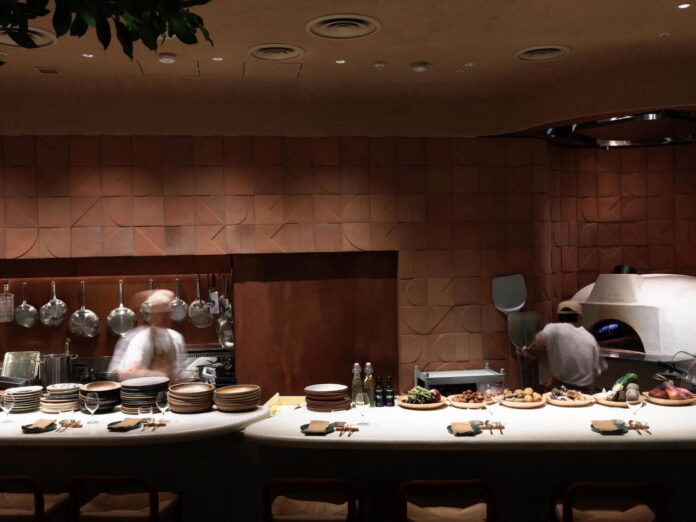Renowned pizza restaurant, Pizza 4P’s, originally established in Vietnam, is set to mark its presence at Azabudai Hills in Tokyo. The establishment, known for its mantra “Pizza for Peace,” was initiated in Vietnam in 2011 under the ownership of a Japanese entrepreneur and has since gained popularity with 32 outlets spanning Vietnam, Cambodia, India, and various other locations.

The first Japanese branch of “Pizza for Peace” has recently opened its doors in Mori Building’s newly developed community, Azabudai Hills. Embracing the ethos of “Earth to People -oneness-,” the Tokyo location will showcase a distinctive Japanese-inspired menu comprising pizzas, pastas, salads, desserts, and beverages, all crafted with meticulously selected ingredients. Notably, the fresh cheese featured in the menu is prepared in-house at the store’s workshop.

The menu features distinctive dishes, including the “Suji-Aonori and Okahijiki Asari” pizza. Suji-Aonori, renowned for its delicate and invigorating aroma among seaweeds, plays a pivotal role in crafting this particular pizza. Characterized by fine, thread-like strands and adorned with a vibrant green color, Suji-Aonori undergoes a meticulous harvesting process from the sea, followed by a careful drying procedure to safeguard its unique qualities. These detailed methods not only preserve the seaweed’s distinct characteristics but also contribute to its sought-after aromatic profile, establishing it as a cherished element in Japanese culinary traditions.

In the culinary world, Suji-Aonori is often used as a key ingredient in various dishes, particularly in the creation of Japanese pizzas, where its distinctive aroma and mild flavor complement other components. The delicate nature of Suji-Aonori makes it an ideal addition to dishes that require a subtle yet impactful seaweed presence.

Okahijiki, known as land seaweed, boasts a vibrant green hue with subtle purple streaks, making it a prominent and cherished ingredient in Japanese cuisine. Its versatility shines through in various culinary applications, frequently featuring in sushi, salads, and as an accompaniment to diverse fish and white meat dishes. In the realm of traditional Japanese cuisine, Okahijiki holds a profound significance, transcending its role as a mere garnish. Instead, it takes center stage in dressed salads, imparting a refreshing crunch and a hint of the sea to these dishes.

Within Japanese culinary practices, Okahijiki’s versatility becomes evident as it seamlessly integrates into an array of recipes. Whether gracing sushi with its fresh and crisp texture or enhancing the overall dining experience as an accompaniment to fish and white meat dishes, Okahijiki contributes a unique flavor and visual appeal to every dish it adorns.

The term “land seaweed” not only describes Okahijiki’s distinctive appearance but also symbolizes Japan’s deep-rooted connection to its natural surroundings. Beyond its culinary role, this designation underscores the importance of incorporating local, sustainable ingredients in Japanese culinary traditions, emphasizing a harmonious relationship between the land and the culinary arts.
Dessert enthusiasts can indulge in delights like “Niida and MAROU Amazake Ice Cream and Fondant Chocolate.” The name “Amazake” literally translates to ‘sweet sake,’ and while it shares some similarities with sake, this elixir is distinct in both flavor and production. Amazake is typically made from rice, with both brown and white rice varieties being used. The fermentation process involves the use of aspergillus oryzae, a fungus that also plays a crucial role in the production of other traditional Japanese foods like miso and natto. The fermentation process is essential in transforming the starches in the rice into natural sugars, resulting in the sweet taste of Amazake.

Amazake boasts a mild, sweet flavor with a hint of rice undertones. The fermentation process imparts a complexity to its taste, making it a versatile ingredient in various culinary applications. Beyond being enjoyed as a beverage, Amazake is a versatile ingredient in Japanese cuisine. It is often used in the preparation of desserts, including ice cream, puddings, and confections. Its natural sweetness makes it an excellent substitute for sugar in recipes, adding a depth of flavor.
All the offerings on the menu draw inspiration from the unique ingredients and culture of Japan, presenting a fusion of flavors.

“Pizza for Peace” at Azabudai Hills officially opened its doors on Friday, November 24, 2023, at Garden Plaza D on the 1st floor, 5-10-7 Toranomon, Minato-ku, Tokyo.
Operating hours are from 11:00-15:00 (last order at 14:00) and 17:00-22:00 (last order at 21:00). The restaurant, boasts a seating capacity of 12 at the counter, 38 at the tables, and 10 on the terrace.
Discover more from SNAP TASTE
Subscribe to get the latest posts sent to your email.



